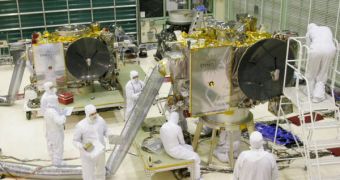The Sun is, indeed, the main reason why life exists on Earth, but solar flares and other types of emissions have the ability to destroy it as well, or at least cause enormous amounts of damage. Among the negative side-effects, experts include large-scale electricity blackouts, destroyed satellites, as well as threats on the lives of astronauts in space at the time. Fortunately, we now have our own “eyes in the sky,” which can detect upcoming solar emissions about 24 hours before they hit Earth.
The STEREO (Solar TErrestrial RElations Observatory) spacecraft are two observatories, nearly identical in shape, size and capabilities, that orbit the Sun in Earth-trailing orbits. One of the observers moves in front of the Earth, gathering data of how the Sun looks like, while the other trails behind our planet's orbit, gathering information of the transformations that solar emissions experience while passing from the first probe to the second.
This detection system allows NASA to be aware of an incoming burst of hot ionized gas, and to issue warnings to the general population, so as to avoid panic. In addition, police and other law enforcement agencies could deploy agents in major cities, in order to prevent looting and fights in the streets. When striking unexpectedly, coronal mass ejections (CME) have the ability to catch authorities off-guard. But now, they can be detected well in advance by the twin observatories, which are scheduled to continue their mission until as late as 2023, when their continuously separating orbits will not allow for direct and effective scientific observations.
In a new scientific study, to be published in an upcoming issue of the scientific journal Geophysical Research Letters, English researchers from the Rutherford Appleton Laboratory in Harwell, Oxfordshire, led by expert Chris Davis, will detail exactly how the spacecraft work together in identifying potentially hazardous CME heading this way. “From both spacecraft, we were able to measure an angle which was consistent and showed it was heading towards Earth,” Davis said, as quoted by NewScientist.

 14 DAY TRIAL //
14 DAY TRIAL //